2. 暨南大学质谱仪器与大气环境研究所, 广州 510632;
3. 广东省大气污染在线源解析系统工程技术研究中心, 广州 510632;
4. 天津天滨瑞成环境技术工程有限公司, 天津 300190;
5. 南开大学计算机学院, 天津 300071
2. Institute of Mass Spectrometer and Atmospheric Environment, Jinan University, Guangzhou 510632;
3. Guangdong Provincial Engineering Research Center for On-line Source Apportionment System of Air Pollution, Guangzhou 510632;
4. Tianjin-Tianbinruicheng Environmental Technology and Engineering Co., Ltd., Tianjin 300190;
5. College of Computer Science, Nankai University, Tianjin 300071
近年来, 中国部分城市空气重污染天气频繁发生给人们的生产生活造成了很大威胁(Jimenez et al., 2009; Mimura et al., 2014; Gao et al., 2015).如何快速解析颗粒物的来源是目前颗粒物污染防治的重点.单颗粒质谱技术能够实时分析大气中颗粒物的粒径和化学组成, 在经过一定时间的采样之后可以获得具有统计意义的颗粒物数目, 可以满足目前颗粒物在线来源解析的需求(Toner et al., 2006; Spencer et al., 2007; Bi et al., 2008;Shields et al., 2008;Pratt et al., 2009; Ma, 2010).目前已经有一些研究应用单颗粒气溶胶质谱仪进行来源解析(Toner et al., 2008; Dall'Osto et al., 2009; Zhang et al., 2009; Healy et al., 2012; Dallosto et al., 2014; Giorio et al., 2015).例如, 一些研究中侧重于分析含特殊成分(如Fe和Pb等)颗粒的可能来源, 其研究方法主要为利用聚类手段获得几个主要的颗粒类别, 并结合化学组成特征、气象条件、粒径分布规律和时间变化趋势等定性判断其可能来源(Toner et al., 2008; Dall'Osto et al., 2009; Zhang et al., 2009; Healy et al., 2012; DallOsto et al., 2014; Giorio et al., 2015); 一些学者利用实验室研究获得的污染源质谱特征与环境中大气颗粒物质谱特征进行比对, 来定量或者半定量源类的贡献(DallOsto et al., 2014; Toner et al., 2018;Xu et al., 2018); 此外, 还有一些学者应用受体模型对环境受体的质谱进行分析, 利用污染源质谱特征作为标准识别各个因子并定量各源类的贡献(Giorio et al., 2015).上述工作能够开展的前提是对污染源单颗粒质谱特征的充分研究.全面了解源排放颗粒物的属性有助于大气污染物的来源解析, 以及评估及控制污染物的影响(陈魁等, 2006).目前, 国内外已经开展了一些对污染源排放颗粒物的单颗粒质谱特征研究, 例如, 土壤风沙尘、机动车直接排放和间接排放、生物质燃烧、生物质锅炉和燃煤锅炉排放等(Silva et al., 1999; Silva et al., 2000; Toner et al., 2006; Shields et al., 2007; Dallosto et al., 2014; Beddows et al., 2016; Xu et al., 2017; Xu et al., 2018).这些研究挖掘了污染源的内混状态和化学组成的粒径分布特征, 为基于单颗粒质谱的源解析工作开展提供了宝贵的经验.
燃煤源是目前中国颗粒物污染的重要贡献源类(Sun et al., 2013).2014年中国煤炭消耗量占总能源消耗量的65.6%, 其中, 火电厂消耗占据了较大比例(Wang et al., 2017).因此, 研究电厂燃煤源成分谱对于解析电厂源贡献, 以及对大气污染防治政策的制定具有重要意义.目前, 国内外对于电厂燃煤单颗粒质谱特征的研究仍较少(Wang et al., 2013; Xu et al., 2017;Xu et al., 2018), 因此, 亟需丰富燃煤源的单颗粒质谱特征.此外, 在以往的研究中多数学者通过采集除尘器下载灰的方式建立燃煤源成分谱, 而不是采集从烟道中排出的实际进入大气环境的颗粒物(陆炳等, 2011; 王毓秀等, 2016; Xu et al., 2017), 对于这两种方式获得的燃煤源化学组成之间差异的研究较少, 且多是基于平均化学组成的角度, 缺乏单颗粒角度的差异性研究.因此, 本文通过比对分析燃煤电厂下载灰样品和烟道气样品获得的单颗粒质谱特征, 以期为后续构建燃煤电厂单颗粒质谱成分谱提供借鉴.
2 材料与方法(Materials and methods) 2.1 采样对象于2017年在天津市选取一个典型燃煤电厂作为研究对象, 进行除尘器下载灰样品和烟道气颗粒物样品的采集及分析, 采样对象基本情况见表 1.
| 表 1 采样对象基本情况 Table 1 Descriptions of tested boiler |
本研究首先采集了该燃煤电厂除尘器下载灰样品, 带回实验室利用再悬浮采样器和单颗粒气溶胶质谱仪(SPAMS)联用的方式进行采样分析, 详细描述见参考文献(Xu et al., 2017).实验装置如图 1a所示, 再悬浮箱体容积为1.5 m3.将采集回的下载灰样品干燥后过400目筛, 然后利用气泵从箱体顶部通入到再悬浮箱体中使其均匀分布.为保证箱体内气压稳定及避免空气背景干扰, 自箱体底部持续通入洁净空气.本研究选择每间隔1 h通入一次样品(约1 mg)以保证再悬浮箱体内样品浓度维持在较高水平.在再悬浮箱体底部使用空气动力学直径为2.5 μm的切割头对源样品进行PM2.5粒径段的切割, 并使用导电硅胶管连接至SPAMS仪器进行样品的采集和分析.
 |
| 图 1 下载灰样品(a)和烟道气样品(b)分析示意图 Fig. 1 Sketch map of analyzing the samples by fly ash/resuspension sampling method(a) and stack gas sampling method by SPAMS(b) |
为了采集并分析烟道气中颗粒物样品, 本研究使用车载单颗粒气溶胶质谱仪在电厂现场采样(车载SPAMS与实验室用仪器结构一致).本研究的采样点设置在脱硫除尘设备之后, 选择在当地环保局设置的常规监测点. SPAMS的采样口通过导电硅胶管连接到烟枪上, 烟枪采样嘴方向与烟道内气流方向相反, 保证烟气能够进入烟气采样系统.从烟囱中采样的流量为25 L · min-1, 以尽量缩短颗粒物在采样管中的停留时间. SPAMS购自广州禾信分析仪器有限公司(型号为0515), 测径范围为0.2~2.0 μm, 其工作原理、基本性能和质量控制已有文献进行了详细阐述(黄正旭等, 2010; Noble et al., 1996; Li et al., 2011; 张芳等, 2008).简单来说, 气溶胶颗粒物以80 mL · min-1的流量进入采样器, 之后颗粒物在空气动力学透镜的作用下聚焦成为准直颗粒束, 离开透镜时颗粒物经气体超声膨胀获得与粒径大小相关的飞行速度.在测径区颗粒连续经过相距6 cm的两束测径激光束(532 nm), 通过测定颗粒物的速度来换算颗粒物的粒径.颗粒物到达电离区后, 被紫外激光脉冲电离(266 nm), 产生的正、负离子经双极飞行时间质量检测系统进行分析检测.电离激光器的能量约为0.5~0.6 mJ, 产生的能量密度约为1.06×108 W · cm-2.定期使用粒径为0.2、0.3、0.5、0.72、1.0、1.3和2.0 μm的聚苯乙烯小球(Polystyrene Latex Spheres, PSLs)对仪器进行粒径校正, 粒径校准系数R2>0.99.采样期间每日进行质谱偏移校准, 以保证质谱峰的准确性.
2.3 粒径分布测定本实验采用颗粒物粒径分级采样仪ELPI(芬兰Dekati公司生产的静电低压撞击器, Electrical Low-Pressure Impactor)在烟道气采样现场进行颗粒物样品浓度和粒径分布的测定.该仪器的工作原理见文献(Giechaskiel et al., 2014; Mirzaei et al., 2015), 可简要概述为:该仪器在撞击器之前加装荷电器使得颗粒物进入撞击器之前饱和荷电, 通过测量每一集收尘基板上的感应电流, 再根据对应的颗粒物粒径段, 可以计算得出该粒径段颗粒物的数浓度.因此, ELPI可以得出颗粒物基于空气动力学当量直径的数浓度.其采样入口流速为10 L · min-1, 13级分级采样的粒径测量范围分别为0.01、0.02、0.04、0.07、0.12、0.20、0.31、0.48、0.76、1.24、2.01、3.01、4.43和7.29 μm.
3 结果与讨论(Results and discussion) 3.1 燃煤尘粒径分布特征本实验利用SPAMS对烟道气样品进行分析后获得测径颗粒数281156个, 有效质谱图数37456个.对下载灰样品进行分析后获得测径颗粒数85190个, 有效质谱图数13815个.SPAMS测得两个样品个数粒径分布见图 2, 两个样品在500~1000 nm范围内出现粒径分布峰值, 且均在500 nm以下测得颗粒较少, 这是由于单颗粒气溶胶质谱仪对不同粒径段颗粒的捕集效率不同, 因此, 其监测得到的颗粒物个数粒径分布与环境真实情况有一定差异(Allen et al., 2000).为了分析该差异, 本研究将烟道气样品的SPAMS测得的个数粒径分布与ELPI测得的数浓度粒径分布(取0.2~2.0 μm)进行比对, 可以看出, 对于真实的烟气排放颗粒物主要分布在较小的粒径段, 而SPAMS对500 nm以上粒径段的检测效果较好.
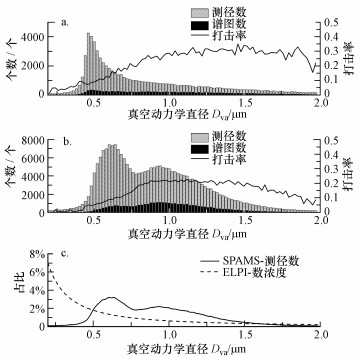 |
| 图 2 SPAMS测得到下载灰样品(a)和烟道气样品(b)的粒径分布图及烟道气样品SPAMS粒径分布与ELPI粒径分布的比对(c) Fig. 2 Size distribution of fly ash/resuspension sampled (a) and stack gas sampled particles (b) analyzed by SPAMS, and compare the particle size distributions measured by SPAMS and ELPI of stack gas sampling (c) |
本实验中共获得了37456个烟道气样品颗粒、13815个下载灰样品颗粒的质谱信息, 将获得的质谱信息中所有质荷比处对应的峰面积取平均值后便可获得两个样品的平均质谱图信息.为了研究燃煤源样品分粒径段的质谱特征, 本研究对粒径段按照0.2~0.5、0.5~1.0、1.0~1.5和1.5~2.0 μm进行划分, 获得的两个样品分粒径段平均质谱如图 3所示.
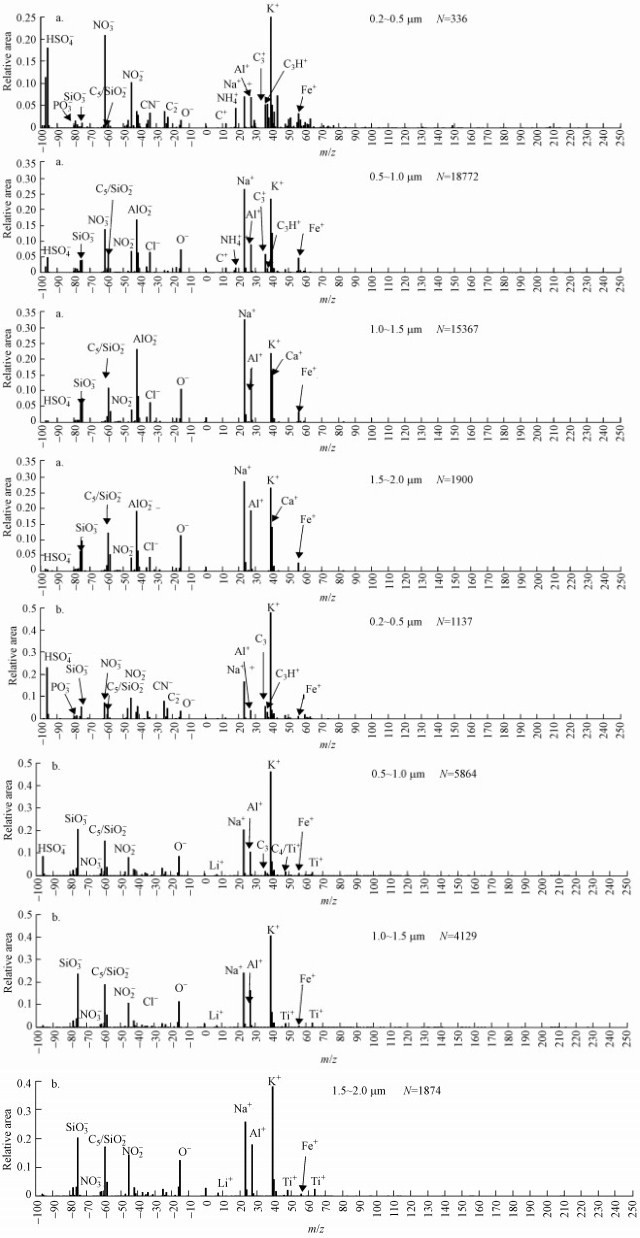 |
| 图 3 烟道气样品(a)和下载灰样品(b)分粒径段平均质谱谱图 Fig. 3 Average mass spectra of fly ash/resuspension sampled (a) and stack gas sampled particles (b) in four size ranges |
下载灰和烟道气样品分粒径段平均质谱相关指数R2分别为0.68(0.2~0.5 μm)、0.61(0.5~1.0 μm)、0.63(1.0~1.5 μm)、0.78(1.5~2.0 μm).总体而言, 两个样品颗粒物平均质谱图具有一定的相似性, 正谱图中均有明显的金属组分的信号(如7Li+、23Na+、39K+、27Al+、40Ca+、48Ti+), 其中, 作为煤矿燃烧颗粒物潜在标识组分的金属锂(m/z=7)(Pougnet et al., 1990; Guazzotti et al., 2003; Liu et al., 2003), 在下载灰样品的平均质谱图中信号峰强度略高于烟道气样品.随着粒径的增加两个样品中金属组分信号强度均逐渐增高, 推测铝、钙、硅等物质含量有所增加.二者负谱图中硅酸盐(60SiO2-、76SiO3-)、二次成分(46NO2-、62NO3-和97HSO4-)等信号比较明显.随着粒径的增加硅酸盐和磷酸盐对应的信号强度逐渐增强, 而硝酸盐和硫酸盐信号强度逐渐降低.造成该现象的原因可能是由于在较细粒径段, 颗粒中的钠、钾组分在高温燃烧时气化凝结生成硫酸盐(K2SO4和Na2SO4), 且新生成的硫酸盐凝结核平均粒径集中在0.5 μm左右(周科, 2011).S属于极易挥发型物质, Na和Ca属于较易挥发型物质, 这些元素在煤炭燃烧时大量挥发, 迁移过程中受气化-凝结等机制控制(潘凤萍等, 2014);并且细颗粒物比表面积和孔体积较大, 更易于吸附和吸收一些挥发型元素, 从而导致这些元素在细颗粒物中富集, 含量随着颗粒粒径减小而增加.此外, 二者正谱图还有较为明显的元素碳的碳簇信号(m/z=12C2+/-、24C2+/-、36C2+/-、48C2+/-、60C2+/-等, 且36C3+和48C4+有较高的信号强度)和有机碳信号(m/z=27C2H3+、37C3H1+等), 且随着粒径的增加碳组分信号强度逐渐减弱.从燃煤颗粒物平均质谱图可以明显看出, 颗粒物中有机组分占比较少, 无机组分占主要地位.原因可能是由于煤燃烧过程中的高温燃烧条件(尤其是燃煤发电过程), 可将有机物完全氧化为CO2或CO, 但颗粒物中仍存在有机组分的原因是燃烧过程中有机物挥发产生的蒸气被无机粒子吸附, 吸附有机物后的无机粒子继续增长, 因此, 抑制了有机物的进一步氧化(Linak et al., 1994; Liu et al., 2003; Healy et al., 2010; Wang et al, 2013).本研究的结果与其他燃煤源颗粒物化学组成的相关研究较为一致, SO42-、Ca、NO3-、OC、EC、Al、Si、Na、Fe等是燃煤源颗粒物的主要化学组分(陆炳等, 2011;王毓秀等, 2016; 李松等, 2016).通过上述对燃煤源分粒径段的平均质谱特征进行分析发现, 对于下载灰样品和烟道气样品, 其化学组成特征在不同粒径段上具有明显差异, 因此, 在后续研究污染源单颗粒质谱特征时需要考虑粒径段间的差异.
3.3 颗粒物分类结果差异通过对比烟道气样品和下载灰样品质谱特征差异性可以看出, 下载灰样品中硅酸盐(m/z= 60SiO2-和76SiO3-)、钛元素(m/z 48Ti+和64TiO+)和锂元素(m/z=7Li+)要略高于烟道气样品, 而烟道气样品中钙/铁元素(m/z=40Ca+和56CaO+)、元素碳(m/z =12C2+/-、24C2+/-、36C2+/-、48C2+/-、60C2+/-等)和有机碳(m/z=27C2H3+、37C3H1+等)信号强度要略高于下载灰样品.为了进一步挖掘其质谱特征的差异, 本研究对烟道气样品和下载灰样品使用ART-2a神经网络算法进行聚类, 以提取二者的主要质谱特征.两个样品所提取的主要特征如图 4所示, 烟道气样品主要分为9类, 分别是富铝类(Al, N=2742, 8.5%)、铝钙类(Al-Ca, N=659, 2.0%)、铝钙元素碳类(Al-Ca-EC, N=494, 1.5%)、铝钙硅酸盐类(Al-Ca-SiO3, N=13272, 41.1%)、铝硅酸盐类(Al-SiO3, N=8888, 27.5%)、铝元素碳类(EC-Al, N=549, 1.7%)、元素碳二次类(EC-Sec, N=2985, 9.2%)、有机碳二次类(OC-Sec, N=326, 1.0%)和富硅酸盐类(SiO3, N=808, 2.5%).这些类别的粒径分布如图 5a所示, 元素碳二次类和有机碳二次类集中于400~800 nm粒径范围内, 而铝硅酸盐类、铝钙硅酸盐类、富硅酸盐类等以硅酸盐和金属组分为主的类别占比随着粒径增大而增高.这也与前文对于烟道气样品分粒径段的平均质谱的分析规律较为一致.
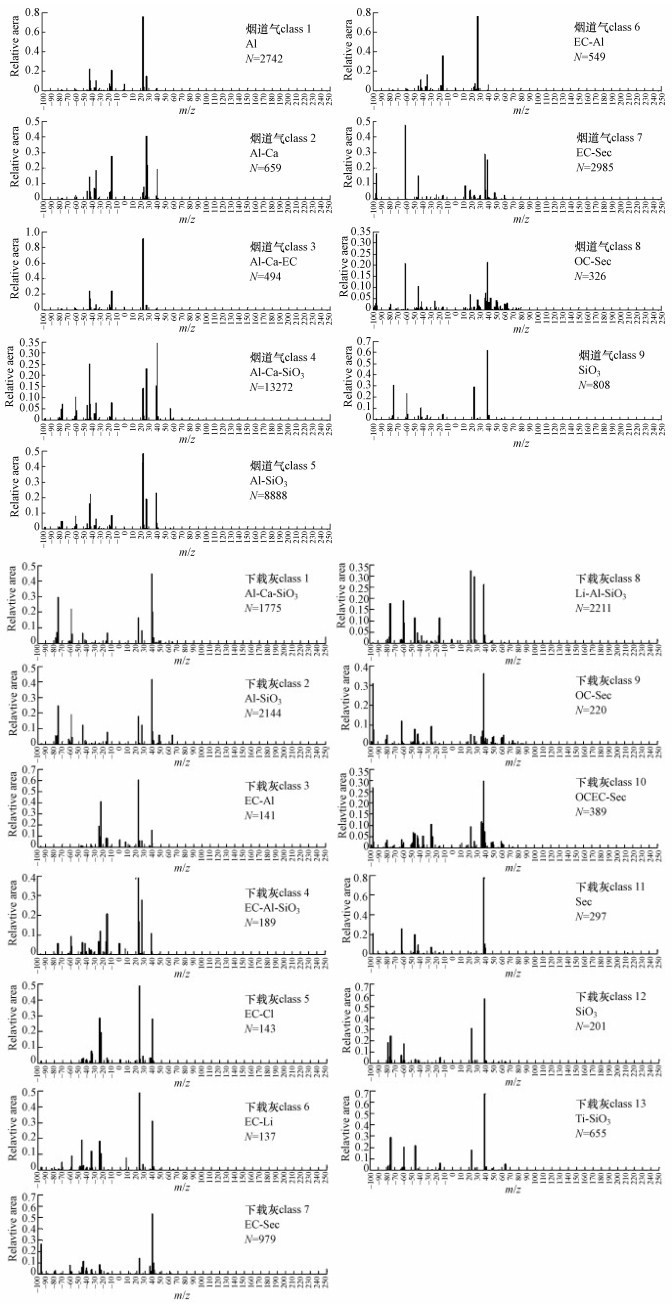 |
| 图 4 烟道气样品和下载灰样品ART-2a所提取的特征质谱谱图 Fig. 4 Average mass spectra of particle classes extracted by ART-2a method of fly ash/resuspension sampled and stack gas sampled particles |
下载灰样品利用ART-2a算法主要分为13类, 分别是铝钙硅酸盐类(Al-Ca-SiO3, N=1775, 14.6%)、铝硅酸盐类(Al-SiO3, N=2144, 17.6%)、铝元素碳类(EC-Al, N=141, 1.2%)、铝硅酸盐元素碳类(EC-Al-SiO3, N=189, 1.6%)、元素碳氯类(EC-Cl, N=143, 1.2%)、锂元素碳类(EC-Li, N=137, 1.1%)、元素碳二次类(EC-Sec, N=979, 8.0%)、锂铝硅酸盐类(Li-Al-SiO3, N=2211, 18.1%)、有机碳二次类(OC-Sec, N=220, 1.8%)、有机碳元素碳二次类(OCEC-Sec, N=389, 3.2%)、二次类(Sec, N=297, 2.4%)、富硅酸盐类(SiO3, N=201, 1.6%)和钛硅酸盐类(Ti-SiO3, N=655, 5.4%).这些类别的粒径分布如图 5b所示, 元素碳二次类、有机碳二次类和元素碳有机碳二次类集中于400~800 nm粒径范围内, 铝钙硅酸盐类颗粒占比峰值出现于800 nm附近, 而铝硅酸盐类、元素碳铝硅酸盐类、钛硅酸盐类等以硅酸盐和金属组分为主的类别占比也随着粒径增大而增高.
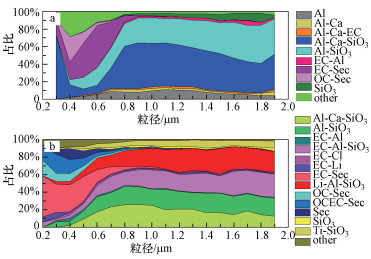 |
| 图 5 烟道气样品(a)和下载灰样品(b)质谱特征的粒径分布规律 Fig. 5 Size distribution patterns of mass spectral features of fly ash/resuspension sampled and stack gas sampled particles |
下载灰样品中部分颗粒物类别成分与烟道气样品较为相近, 例如, 它们均含有元素碳二次类、有机碳二次类、铝元素碳类、铝钙硅酸盐类和富硅酸盐类等颗粒物类别, 但含钙颗粒物类别在烟道气样品中的比例要高于下载灰样品, 并且含钙颗粒的粒径分布规律略有差异.这是由于燃煤烟气排放的颗粒在经过除尘器后, 经过脱硫系统(本研究中采样电厂利用石灰石石膏法脱硫)会夹带细的石膏泥浆, 导致细颗粒物上S、Ca、Na含量增加.此外, 在下载灰样品中部分颗粒物类中会含有锂信号峰(m/z=7)和钛信号峰(m/z=48和64), 在烟道气样品中这些信号峰较不明显.这可能是由于除尘系统(本研究中采样电厂利用静电除尘系统)对颗粒物脱除效率很高, 从而导致部分颗粒物类别在经过除尘系统被脱除.研究表明, 静电除尘系统对PM0.2~1.0和PM0.2~2.5的脱除率均高于99%(潘凤萍等, 2014).此外, 燃煤颗粒在经过除尘系统后的运动过程中(如进入脱硫系统等)有其他物质迁移到颗粒物上(潘凤萍等, 2014), 从而导致Ti/Li等元素的含量比例降低, 因而导致在颗粒物质谱上特征不明显.
为了进一步比对烟道气样品和下载灰样品质谱特征的差异性, 本研究使用向量点积作为评估两个颗粒物类别质谱相似性的指标, 结果如图 6所示.向量点积越接近于1(在图中表现为颜色越接近于红色), 则两个向量间夹角越小, 即两个质谱越相似.反之向量点积越接近于0(在图中表现为颜色越接近于蓝色), 则两个向量间夹角越大, 即两个质谱越不相似.由图可知, 下载灰样品中的铝元素碳类与烟道气样品中的铝钙元素碳类和富铝类的向量点积较大.烟道气样品中的富硅酸盐类与下载灰样品中的铝钙硅酸盐类、铝硅酸盐类、锂铝钙硅酸盐类、富硅酸盐类和钛硅酸盐类的向量点积较大.而其他大部分颗粒物类别向量点积则较小.结果表明, 化学成分特征越为相近的颗粒物类别其向量点积越大, 但仍有部分成分有差异的颗粒物类别间向量点积较大, 原因可能为信号强度较高的荷质比在计算向量点积过程中起到了决定性作用(Xu et al., 2017).总体来说, 烟道气样品和下载灰样品颗粒物的质谱特征呈现着一定的差异性.
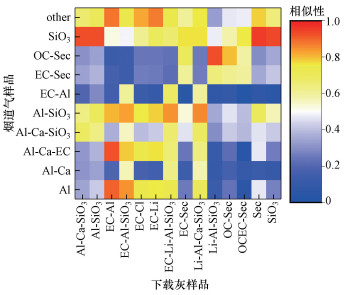 |
| 图 6 烟道气样品和下载灰样品单颗粒质谱特征相似性分析 Fig. 6 Similarity analysis of mass spectral features of fly ash/resuspension sampled and stack gas sampled particles |
1) SPAMS监测得到烟道气样品和下载灰样品颗粒物均在500~1000 nm范围内出现峰值且在小粒径段分布较少, 且与ELPI监测得到的数浓度粒径分布特征有明显差异.分析源排放颗粒物的真实粒径分布对于源成分谱的构建、颗粒物源解析研究具有非常重要的意义.
2) 烟道气样品和下载灰样品颗粒物平均质谱图具有相似性, 正谱图中有非常明显的金属组分信号(如7Li+、23Na+、39K+、27Al+、40Ca+、48Ti+), 负谱图中硅酸盐、二次成分等信号比较明显(60SiO2-、76SiO3-、46NO2-、62NO3-和97HSO4-).整体而言, 有机组分信号峰较弱, 无机组分信号峰较强.不同粒径范围内颗粒物质谱特征具有显著差异性, 并且随着粒径的增加碳组分、硫酸盐、硝酸盐等组分对应信号强度逐渐减弱, 而硅酸盐、磷酸盐、铝、钙、钛等组分信号强度逐渐增强.其中, 硅酸盐、钛和锂等组分信号强度在下载灰样品中略高于烟道气样品, 而钙和碳等组分信号强度在下载灰样品中略低于烟道气样品.
3) 燃煤尘样品使用ART-2a聚类后颗粒物类别组成情况较为复杂.烟道气样品主要分为富铝类(Al)、铝钙类(Al-Ca)、铝钙元素碳类(Al-Ca-EC)、铝钙硅酸盐类(Al-Ca-SiO3)、铝硅酸盐类(Al-SiO3)、铝元素碳类(EC-Al)、元素碳二次类(EC-Sec)、有机碳二次类(OC-Sec)和富硅酸盐类(SiO3)共9类; 下载灰样品主要分为铝钙硅酸盐类(Al-Ca-SiO3)、铝硅酸盐类(Al-SiO3)、铝元素碳类(EC-Al)、铝硅酸盐元素碳类(EC-Al-SiO3)、元素碳氯类(EC-Cl)、锂元素碳类(EC-Li)、元素碳二次类(EC-Sec)、锂铝硅酸盐类(Li-Al-SiO3)、有机碳二次类(OC-Sec)、有机碳元素碳二次类(OCEC-Sec)、二次类(Sec)、富硅酸盐类(SiO3)和钛硅酸盐类(Ti-SiO3)共13类.含碳组分(包括OC和EC)、二次组分(包括SO42-和NO3-)等的颗粒物类别集中在 < 800 nm的粒径范围内, 而以金属和硅酸盐为主要组分的颗粒物类别占比随着粒径增大而增高.因此, 今后在构建基于单颗粒质谱的源成分谱时, 要分粒径段考虑, 并且使用聚类方法能够有效提取各粒径段内的质谱信息.
4) 燃煤烟道气样品和下载灰样品在化学组成上和单颗粒质谱特征上呈现着显著差异.下载灰样品不能代表真实排放特征, 因而后续研究燃煤源等固定燃烧源的单颗粒质谱源成分谱等工作的开展应利用单颗粒质谱仪在外场进行实测.
Allen J O, Fergenson D P, Gard E E, et al. 2000. Particle detection efficiencies of aerosol time of flight mass spectrometers under ambient sampling conditions[J]. Environmental Science & Technology, 34(1): 211–217.
|
Beddows D C S, Dall'Osto M, Olatunbosun O A, et al. 2016. Detection of brake wear aerosols by aerosol time-of-flight mass spectrometry[J]. Atmospheric Environment, 129: 167–175.
DOI:10.1016/j.atmosenv.2016.01.018
|
Bi X, Simoneit B R T, Sheng G, et al. 2008. Composition and major sources of organic compounds in urban aerosols[J]. Atmospheric Research, 88(3/4): 256–265.
|
Bond T C, Streets D G, Yarber K F. 2004. A technology-based global inventory of black and organic carbon emissions from combustion[J]. Journal of Geophysical Research, 109(D14).
DOI:10.1029/2003JD003697
|
陈魁, 白志鹏. 2006. 颗粒物再悬浮采样器研制与应用[J]. 环境工程, 2006, 24(5): 67–68.
DOI:10.3969/j.issn.1000-8942.2006.05.022 |
Dallosto M, Beddows D C, Gietl J K, et al. 2014. Characteristics of tyre dust in polluted air:Studies by single particle mass spectrometry (ATOFMS)[J]. Atmospheric Environment, 94: 224–230.
DOI:10.1016/j.atmosenv.2014.05.026
|
Damle A S, Ensor D S, Ranade M B. 1982. Coal combustion aerosol formation mechanisms-A review[J]. Aerosol Science and Technology, 1: 119–133.
|
Dall'Osto M, Harrison R M, Coe H, et al. 2009. Real time chemical characterization of local and regional nitrate aerosols[J]. Atmospheric Chemistry & Physics, 9: 3709–3720.
|
付怀于, 闫才青, 郑玫, 等. 2014. 在线单颗粒气溶胶质谱SPAMS对细颗粒物中主要组分提取方法的研究[J]. 环境科学, 2014, 35(11): 4070–4077.
|
Gao J, Tian H, Cheng K, et al. 2015. The variation of chemical characteristics of PM2.5, and PM10, and formation causes during two haze pollution events in urban beijing, china[J]. Atmospheric Environment, 107: 1–8.
DOI:10.1016/j.atmosenv.2015.02.022
|
Guazzotti S A, Suess D T, Coffee K R, et al. 2003. Characterization of carbonaceous aerosols outflow from India andArabia:Biomass/biofuel burning and fossil fuel combustion[J]. Journal of Geophysical Research, 108(D15): 1211–1222.
|
Giechaskiel B, Maricq M, Ntziachristos L, et al. 2014. Review of motor vehicle particulate emissions sampling and measurement:From smoke and filter mass to particle number[J]. Journal of Aerosol Science, 67: 48–86.
DOI:10.1016/j.jaerosci.2013.09.003
|
Giorio C, Tapparo A, Dall'Osto M, et al. 2015. Local and regional components of aerosol in a heavily trafficked street canyon in central London derived from PMF and cluster analysis of single particle ATOFMS spectra[J]. Environmental Science & Technology, 49: 3330–3340.
|
Haynes B S, Neville M, Quann R J, et al. 1982. Factors governing the surface enrichment of fly-ash in volatile trace species[J]. Journal of Colloid and Interface Science, 87: 266–278.
DOI:10.1016/0021-9797(82)90388-5
|
Healy R M, Hellebust S, Kourtchev I, et al. 2010. Source apportionment of PM2.5 in Cork Harbour, Ireland using a combination of single particle mass spectrometry and quantitative semi-continuous measurements[J]. Atmospheric Chemistry and Physics, 10(19): 9593–9613.
DOI:10.5194/acp-10-9593-2010
|
Healy R M, Sciare J, Poulain L, et al. 2012. Sources and mixing state of size-resolved elemental carbon particles in a European megacity:Paris[J]. Atmospheric Chemistry and Physics, 12(4): 1681–1700.
DOI:10.5194/acp-12-1681-2012
|
黄正旭, 高伟, 董俊国, 等. 2010. 实时在线单颗粒气溶胶飞行时间质谱仪的研制[J]. 质谱学报, 2010, 31(6): 331–336.
|
Jimenez E, Linares C, Rodriguez L F, et al. 2009. Short-term impact of particulate matter (PM2.5) on daily mortality among the over-75 age group in Madrid (Spain)[J]. Science of the Total Environment, 407: 5486–5492.
DOI:10.1016/j.scitotenv.2009.06.038
|
李松, 郎建垒, 程水源, 等. 2016. 典型固定燃烧源颗粒物成分谱特征研究[J]. 安全与环境学报, 2016, 16(5): 312–319.
|
Li L, Tan G B, Zhang L, et al. 2013. Analysis of diesel exhaust particles using single particle aerosol mass spectrometry[J]. Chinese Journal of Analytical Chemistry, 41(12): 1831–1836.
|
Li L, Li M, Huang Z, et al. 2014. Ambient particle characterization by single particle aerosol mass spectrometry in an urban area of Beijing[J]. Atmospheric Environment, 94: 323–331.
DOI:10.1016/j.atmosenv.2014.03.048
|
Li L, Huang Z X, Dong J G, et al. 2011. Real time bipolar time-of-flight mass spectrometer for analyzing single aerosol particles[J]. International Journal of Mass Spectrometry, 303(2/3): 118–124.
|
Linak W P, Wendt J O L. 1994. Trace metal transformation mechanisms during coal combustion[J]. Fuel Processing Technology, 39: 173–198.
DOI:10.1016/0378-3820(94)90179-1
|
Liu D Y, Wenzel R J, Prather K A. 2003. Aerosol time-of-flight mass spectrometry during the Atlanta supersite experiment:1.Measurements[J]. Journal of Geophysical Research:Atmospheres, 108.
DOI:10.1029/2001JD001562
|
陆炳, 孔少飞, 韩斌, 等. 2011. 燃煤锅炉排放颗粒物成分谱特征研究[J]. 煤炭学报, 2011, 36(11): 1928–1933.
|
Ma S X. 2010. Stable carbon isotopic compositions of organic acids in total suspended particles and dusts from Guangzhou, China[J]. Atmospheric Research, 98: 176–182.
DOI:10.1016/j.atmosres.2010.07.003
|
Mimura T, Ichinose T, Yamagami S, et al. 2014. Airborne particulate matter (PM2.5) and the prevalence of allergic conjunctivitis in Japan[J]. Science of the Total Environment, 487: 493–499.
DOI:10.1016/j.scitotenv.2014.04.057
|
Mirzaei M, Mosaffa M, Mohammadi S. 2015. Variation-aware approaches with power improvement in digital circuits[J]. Integration, the VLSI Journal, 48: 83–100.
DOI:10.1016/j.vlsi.2014.07.001
|
Mu Y Y, Lou S R, Chen C H, et al. 2013. Aging and mixing state of particulate matter during aerosol pollution episode in autumn Shanghai using a single particle aerosol mass spectrometer (SPAMS)[J]. Enviromental Science, 34(6): 2071–2080.
|
潘凤萍, 陈华忠, 庞志强, 等. 2014. 燃煤电厂锅炉中颗粒物在选择性催化还原、静电除尘器和烟气脱硫入口处的分布特性[J]. 中国电机工程学报, 2014, 34(32): 5728–5733.
|
Pratt K A, Prather K A. 2009. Real-time, single-particle volatility, size, and chemical composition measurements of aged urban aerosols[J]. Environmental Science & Technology, 43: 8276–8282.
|
Pougnet M A B, Wyrley-Birch J M, Orren M J. 1990. The boron and lithium content of South African coals and coal ashes[J]. International Journal of Environmental Analytical Chemistry, 38(4): 539–549.
DOI:10.1080/03067319008026956
|
Noble C A, Prather K A. 1996. Real-time measurement of correlated size and composition profiles of individual atmospheric aerosol particles[J]. Environmental Science & Technology, 30(9): 2667–2680.
|
Quann R J, Neville M, Janghorbani M. 1982. Mineral matter and trace-element vaporization in a laboratory-pulverized coal combustion system[J]. Environmental Science & Technology, 16: 776–781.
|
Shi G L, Xu J, Peng X, et al. 2016. Using a new WALSPMF model to quantify the source contributions to PM2.5 at a harbour site in China[J]. Atmospheric Environment, 126: 66–75.
DOI:10.1016/j.atmosenv.2015.11.046
|
Shields L G, Suess D T, Prather K A. 2007. Determination of single particle mass spectral signatures from heavy-duty diesel vehicle emissions for PM2.5 source apportionment[J]. Atmospheric Environment, 41(18): 3841–3852.
DOI:10.1016/j.atmosenv.2007.01.025
|
Silva P J, Liu D Y, Noble C A, et al. 1999. Size and chemical characterization of individual particles resulting from biomass burning of local Southern California species[J]. Environmental Science & Technology, 33(18): 3068–3076.
|
Silva P J, Carlin R A, Prather K A. 2000. Single particle analysis of suspended soil dust from Southern California[J]. Atmospheric Environment, 34(11): 1811–1820.
DOI:10.1016/S1352-2310(99)00338-6
|
Song X H, Hopke P K, Fergenson D P, et al. 1999. Classification of single particles analyzed by ATOFMS using an artificial neural network, ART-2A[J]. Analytical Chemistry, 71: 860–865.
DOI:10.1021/ac9809682
|
Sun Y L, Wang Z F, Fu P Q, et al. 2013. Aerosol composition, sources and processes during wintertime in beijing, China[J]. Atmospheric Chemistry and Physics, 13(9): 4577–4592.
DOI:10.5194/acp-13-4577-2013
|
Spencer M T, Holecek J C, Corrigan C E, et al. 2007. Size-resolved chemical composition of aerosol particles during a monsoonal transition period over the indian ocean[J]. Journal of Geophysical Research, 113(D16): 280–288.
|
Suriyawong A, Gamble M, Lee M H. 2006. Submicrometer particle formation and mercury speciation under O2-CO2 coal combustion[J]. Energy Fuels, 20: 2357–2363.
DOI:10.1021/ef060178s
|
Tian Y Z, Wang J, Peng X, et al. 2014. Estimation of the direct and indirect impacts of fireworks on the physicochemical characteristics of atmospheric PM10 and PM2.5[J]. Atmospheric Chemistry and Physics, 14(18): 9469–9479.
DOI:10.5194/acp-14-9469-2014
|
Toner S M, Shields L G, Sodeman D A, et al. 2008. Using mass spectral source signatures to apportion exhaust particles from gasoline and diesel powered vehicles in a freeway study using UF-ATOFMS[J]. Atmospheric Environment, 42(3): 568–581.
DOI:10.1016/j.atmosenv.2007.08.005
|
Toner S M, Sodeman D A, Prather K A. 2006. Single particle characterization of ultrafine and accumulation mode particles from heavy duty diesel vehicles using aerosol time-of-flight mass spectrometry[J]. Environmental Science & Technology, 40(12): 3912–3921.
|
王毓秀, 彭林, 王燕, 等. 2016. 电厂燃煤烟尘PM2.5中化学组分特征[J]. 环境科学, 2016, 37(1): 60–65.
DOI:10.3969/j.issn.1673-288X.2016.01.017 |
Wang X, Williams B J, Wang X, et al. 2013. Biswas characterization of organic aerosol produced during pulverized[J]. Atmospheric Chemistry and Physics, 13: 10919–10932.
DOI:10.5194/acp-13-10919-2013
|
Wang S, Luo K. 2017. Atmospheric emission of mercury due to combustion of steam coal and domestic coal in China[J]. Atmospheric Environment, 162: 45–54.
DOI:10.1016/j.atmosenv.2017.05.015
|
Wang X, Tang Y, Huang Y P, et al. 2013. Characterization of organic aerosol produced during pulverized coal combustion in a drop tube furnace[J]. Atmospheric Chemistry and Physics, 13(21): 10919–10932.
DOI:10.5194/acp-13-10919-2013
|
Xu J, Li M, Shi G L, et al. 2017. Mass spectra features of biomass burning boiler and coal burning boiler emitted particles by single particle aerosol mass spectrometer[J]. Science of the Total Environment, 598: 341.
DOI:10.1016/j.scitotenv.2017.04.132
|
Xu J, Wang H, Li X, et al. 2018. Refined source apportionment of coal combustion sources by using single particle mass spectrometry[J]. Science of the Total Environment, 627: 633–646.
DOI:10.1016/j.scitotenv.2018.01.269
|
Zhang Y M, Zhang X Y, Sun J Y, et al. 2014. Chemical composition and mass size distribution of PM1 at an elevated site in central east China[J]. Atmospheric Chemistry and Physics, 14(22): 12237–12249.
DOI:10.5194/acp-14-12237-2014
|
Zhang R, Jing J, Tao J, et al. 2013. Chemical characterization and source apportionment of PM2.5 in Beijing, seasonal perspective[J]. Atmospheric Chemistry and Physics, 13: 7053–7074.
DOI:10.5194/acp-13-7053-2013
|
Zhang G, Bi X, Chan L Y, et al. 2012. Enhanced trimethylamine-containing particles during fog events detected by single particle aerosol mass spectrometry in urban Guangzhou, China[J]. Atmospheric Environment, 55: 121–126.
DOI:10.1016/j.atmosenv.2012.03.038
|
Zhang Y, Wang X, Chen H, et al. 2009. Source apportionment of lead-containing aerosol particles in Shanghai using single particle mass spectrometry[J]. Chemosphere, 74(4): 501–507.
DOI:10.1016/j.chemosphere.2008.10.004
|
张芳, 王淑芳, 郭长娟, 等. 2008. 单颗粒气溶胶实时在线监测飞行时间质谱仪的研制[J]. 现代仪器与医疗, 2008, 14(1): 49–52.
|
Zhuang Y, Biswas P. 2001. Submicrometer particle formation and control in a bench-scale pulverized coal combustor[J]. Energy Fuels, 15: 510–516.
DOI:10.1021/ef000080s
|
周科.2011.燃煤细微颗粒物生成特性与炉内控制的研究[D]武汉: 华中科技大学
http://cdmd.cnki.com.cn/article/cdmd-10487-1011110390.htm |
赵永椿, 张军营, 张富强, 等. 2007. 燃煤高钙灰的组成及其演化机制的研究[J]. 中国电机工程学报, 2007, 27(29): 12–16.
DOI:10.3321/j.issn:0258-8013.2007.29.003 |
 2019, Vol. 39
2019, Vol. 39


